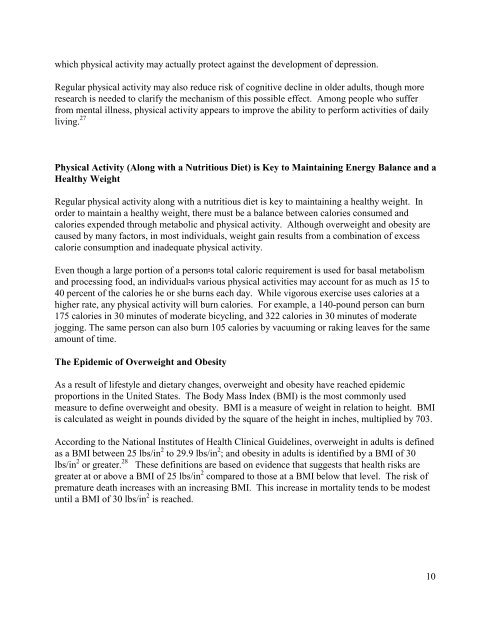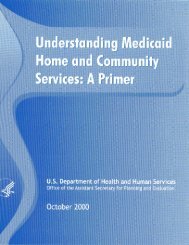physical activity fundamental to preventing disease - ASPE - U.S. ...
physical activity fundamental to preventing disease - ASPE - U.S. ...
physical activity fundamental to preventing disease - ASPE - U.S. ...
You also want an ePaper? Increase the reach of your titles
YUMPU automatically turns print PDFs into web optimized ePapers that Google loves.
which <strong>physical</strong> <strong>activity</strong> may actually protect against the development of depression.<br />
Regular <strong>physical</strong> <strong>activity</strong> may also reduce risk of cognitive decline in older adults, though more<br />
research is needed <strong>to</strong> clarify the mechanism of this possible effect. Among people who suffer<br />
from mental illness, <strong>physical</strong> <strong>activity</strong> appears <strong>to</strong> improve the ability <strong>to</strong> perform activities of daily<br />
living. 27<br />
Physical Activity (Along with a Nutritious Diet) is Key <strong>to</strong> Maintaining Energy Balance and a<br />
Healthy Weight<br />
Regular <strong>physical</strong> <strong>activity</strong> along with a nutritious diet is key <strong>to</strong> maintaining a healthy weight. In<br />
order <strong>to</strong> maintain a healthy weight, there must be a balance between calories consumed and<br />
calories expended through metabolic and <strong>physical</strong> <strong>activity</strong>. Although overweight and obesity are<br />
caused by many fac<strong>to</strong>rs, in most individuals, weight gain results from a combination of excess<br />
calorie consumption and inadequate <strong>physical</strong> <strong>activity</strong>.<br />
Even though a large portion of a person=s <strong>to</strong>tal caloric requirement is used for basal metabolism<br />
and processing food, an individual=s various <strong>physical</strong> activities may account for as much as 15 <strong>to</strong><br />
40 percent of the calories he or she burns each day. While vigorous exercise uses calories at a<br />
higher rate, any <strong>physical</strong> <strong>activity</strong> will burn calories. For example, a 140-pound person can burn<br />
175 calories in 30 minutes of moderate bicycling, and 322 calories in 30 minutes of moderate<br />
jogging. The same person can also burn 105 calories by vacuuming or raking leaves for the same<br />
amount of time.<br />
The Epidemic of Overweight and Obesity<br />
As a result of lifestyle and dietary changes, overweight and obesity have reached epidemic<br />
proportions in the United States. The Body Mass Index (BMI) is the most commonly used<br />
measure <strong>to</strong> define overweight and obesity. BMI is a measure of weight in relation <strong>to</strong> height. BMI<br />
is calculated as weight in pounds divided by the square of the height in inches, multiplied by 703.<br />
According <strong>to</strong> the National Institutes of Health Clinical Guidelines, overweight in adults is defined<br />
as a BMI between 25 lbs/in 2 <strong>to</strong> 29.9 lbs/in 2 ; and obesity in adults is identified by a BMI of 30<br />
lbs/in 2 or greater. 28 These definitions are based on evidence that suggests that health risks are<br />
greater at or above a BMI of 25 lbs/in 2 compared <strong>to</strong> those at a BMI below that level. The risk of<br />
premature death increases with an increasing BMI. This increase in mortality tends <strong>to</strong> be modest<br />
until a BMI of 30 lbs/in 2 is reached.<br />
10
















